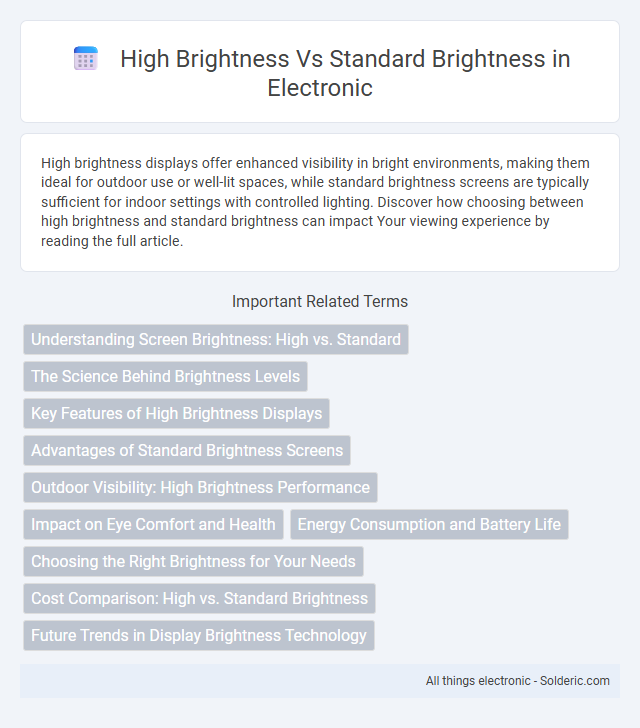High brightness displays offer enhanced visibility in bright environments, making them ideal for outdoor use or well-lit spaces, while standard brightness screens are typically sufficient for indoor settings with controlled lighting. Discover how choosing between high brightness and standard brightness can impact Your viewing experience by reading the full article.
Comparison Table
| Feature | High Brightness | Standard Brightness |
|---|---|---|
| Brightness Level (nits) | 1000+ nits | 200-500 nits |
| Use Case | Outdoor visibility, direct sunlight | Indoor use, controlled lighting |
| Power Consumption | Higher | Lower |
| Cost | Premium pricing | More affordable |
| Lifespan | Comparable to standard if properly managed | Standard expectancy |
| Color Accuracy | Enhanced for visibility | Standard color gamut |
Understanding Screen Brightness: High vs. Standard
Screen brightness significantly impacts visibility and comfort, with high brightness screens offering luminance levels typically above 700 nits compared to standard brightness displays around 300-500 nits. High brightness screens enhance readability in direct sunlight and vibrant environments, ensuring your content remains clear and vivid under various lighting conditions. Choosing the right brightness level affects battery consumption, with brighter screens generally using more power, so understanding your usage needs helps optimize your device's performance.
The Science Behind Brightness Levels
Brightness levels are measured in lumens, indicating the amount of light emitted by a source. High brightness displays typically exceed 1,000 lumens, enhancing visibility in well-lit environments by combating ambient light interference. Standard brightness screens, usually ranging between 200 and 500 lumens, are sufficient for controlled indoor settings but struggle with glare and visibility under direct sunlight.
Key Features of High Brightness Displays
High brightness displays typically offer luminance levels exceeding 1,000 nits, enabling clear visibility even under direct sunlight or bright ambient conditions. These screens incorporate advanced technologies such as optical bonding and anti-reflective coatings to reduce glare and enhance contrast, ensuring vibrant image quality. High brightness displays are essential in environments like outdoor digital signage, industrial control panels, and automotive dashboards where readability is critical.
Advantages of Standard Brightness Screens
Standard brightness screens offer advantages such as lower energy consumption, leading to extended battery life in portable devices. They generate less heat, contributing to improved device longevity and user comfort. Additionally, standard brightness displays are often more cost-effective, making them suitable for budget-conscious consumers and widespread applications.
Outdoor Visibility: High Brightness Performance
High brightness displays significantly enhance outdoor visibility by producing luminance levels typically above 1,000 nits, compared to standard brightness screens that average around 300-500 nits. This increased brightness ensures clear image and text readability even under direct sunlight, reducing glare and reflections that impair viewing quality. Your outdoor visual experience improves dramatically with high brightness technology, making it ideal for smartphones, digital signage, and automotive displays.
Impact on Eye Comfort and Health
High brightness displays emit more intense light, which can cause increased eye strain and discomfort during prolonged use compared to standard brightness screens. Excessive brightness leads to glare and blue light exposure, contributing to digital eye fatigue, dry eyes, and potential disruptions in circadian rhythms. Standard brightness levels generally offer a more comfortable viewing experience, reducing the risk of eye health issues associated with prolonged screen time.
Energy Consumption and Battery Life
High brightness displays consume significantly more energy than standard brightness screens, which can lead to faster battery drain in portable devices. Choosing a high brightness setting increases power usage by up to 30%, reducing your device's operational time between charges. Optimizing brightness levels based on your environment helps balance visibility and prolong battery life.
Choosing the Right Brightness for Your Needs
Selecting the appropriate brightness level depends on the environment and usage requirements, with high brightness displays offering 1,000 to over 3,000 nits ideal for outdoor or brightly lit settings, ensuring clear visibility under direct sunlight. Standard brightness screens, typically ranging from 200 to 500 nits, suffice for indoor use or controlled lighting conditions, providing energy efficiency and reduced eye strain. Evaluating ambient light levels and intended display applications helps determine the optimal brightness setting for performance and comfort.
Cost Comparison: High vs. Standard Brightness
High brightness displays usually cost significantly more than standard brightness models due to advanced LED technology and enhanced durability for brighter environments. While standard brightness screens range from $100 to $300, high brightness options can exceed $500, reflecting their specialized performance in sunlight or outdoor settings. Your investment in high brightness is justified if visibility in direct light is crucial, though standard brightness screens offer better affordability for indoor use.
Future Trends in Display Brightness Technology
High brightness displays are rapidly evolving with advancements in mini-LED and micro-LED technologies, offering superior luminance levels compared to standard brightness screens, enhancing visibility in various lighting conditions. Future trends emphasize energy-efficient brightness solutions that maintain vivid colors and sharp contrast while reducing power consumption and heat generation. Your choice of display will increasingly benefit from these innovations, delivering enhanced viewing experiences for outdoor and high ambient light environments.
High Brightness vs Standard Brightness Infographic

 solderic.com
solderic.com